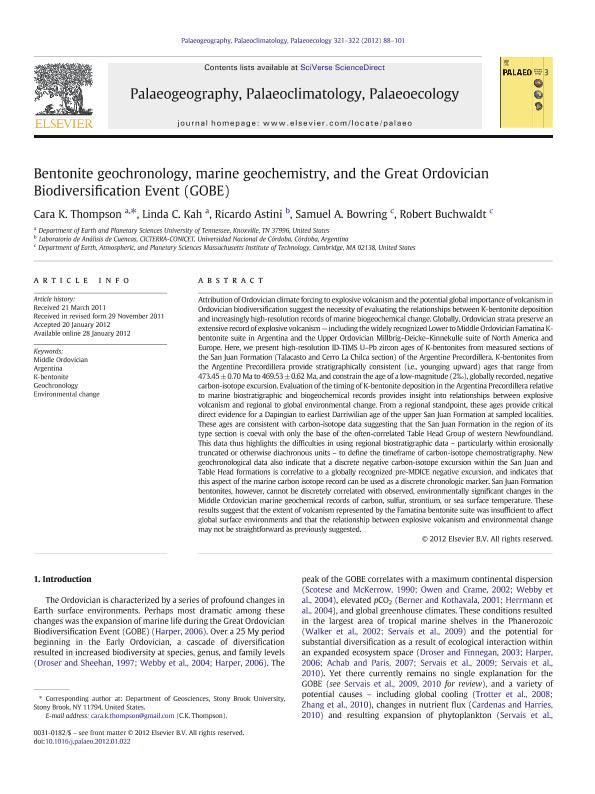Mostrar el registro sencillo del ítem
dc.contributor.author
Thompson, Cara K.
dc.contributor.author
Kah, Linda C.
dc.contributor.author
Astini, Ricardo Alfredo

dc.contributor.author
Bowring, Samuel A.
dc.contributor.author
Buchwaldt, Robert
dc.date.available
2018-07-16T17:19:47Z
dc.date.issued
2012-03
dc.identifier.citation
Thompson, Cara K.; Kah, Linda C.; Astini, Ricardo Alfredo; Bowring, Samuel A.; Buchwaldt, Robert; Bentonite geochronology, marine geochemistry, and the Great Ordovician Biodiversification Event (GOBE); Elsevier Science; Palaeogeography, Palaeoclimatology, Palaeoecology; 321-322; 3-2012; 88-101
dc.identifier.issn
0031-0182
dc.identifier.uri
http://hdl.handle.net/11336/52203
dc.description.abstract
Attribution of Ordovician climate forcing to explosive volcanism and the potential global importance of volcanism in Ordovician biodiversification suggest the necessity of evaluating the relationships between K-bentonite deposition and increasingly high-resolution records of marine biogeochemical change. Globally, Ordovician strata preserve an extensive record of explosive volcanism - including the widely recognized Lower to Middle Ordovician Famatina K-bentonite suite in Argentina and the Upper Ordovician Millbrig-Deicke-Kinnekulle suite of North America and Europe. Here, we present high-resolution ID-TIMS U-Pb zircon ages of K-bentonites from measured sections of the San Juan Formation (Talacasto and Cerro La Chilca section) of the Argentine Precordillera. K-bentonites from the Argentine Precordillera provide stratigraphically consistent (i.e., younging upward) ages that range from 473.45 ± 0.70. Ma to 469.53 ± 0.62. Ma, and constrain the age of a low-magnitude (2%), globally recorded, negative carbon-isotope excursion. Evaluation of the timing of K-bentonite deposition in the Argentina Precordillera relative to marine biostratigraphic and biogeochemical records provides insight into relationships between explosive volcanism and regional to global environmental change. From a regional standpoint, these ages provide critical direct evidence for a Dapingian to earliest Darriwilian age of the upper San Juan Formation at sampled localities. These ages are consistent with carbon-isotope data suggesting that the San Juan Formation in the region of its type section is coeval with only the base of the often-correlated Table Head Group of western Newfoundland. This data thus highlights the difficulties in using regional biostratigraphic data - particularly within erosionally truncated or otherwise diachronous units - to define the timeframe of carbon-isotope chemostratigraphy. New geochronological data also indicate that a discrete negative carbon-isotope excursion within the San Juan and Table Head formations is correlative to a globally recognized pre-MDICE negative excursion, and indicates that this aspect of the marine carbon isotope record can be used as a discrete chronologic marker. San Juan Formation bentonites, however, cannot be discretely correlated with observed, environmentally significant changes in the Middle Ordovician marine geochemical records of carbon, sulfur, strontium, or sea surface temperature. These results suggest that the extent of volcanism represented by the Famatina bentonite suite was insufficient to affect global surface environments and that the relationship between explosive volcanism and environmental change may not be straightforward as previously suggested. © 2012 Elsevier B.V.
dc.format
application/pdf
dc.language.iso
eng
dc.publisher
Elsevier Science

dc.rights
info:eu-repo/semantics/openAccess
dc.rights.uri
https://creativecommons.org/licenses/by-nc-sa/2.5/ar/
dc.subject
Argentina
dc.subject
Environmental Change
dc.subject
Geochronology
dc.subject
K-Bentonite
dc.subject
Middle Ordovician
dc.subject.classification
Meteorología y Ciencias Atmosféricas

dc.subject.classification
Ciencias de la Tierra y relacionadas con el Medio Ambiente

dc.subject.classification
CIENCIAS NATURALES Y EXACTAS

dc.title
Bentonite geochronology, marine geochemistry, and the Great Ordovician Biodiversification Event (GOBE)
dc.type
info:eu-repo/semantics/article
dc.type
info:ar-repo/semantics/artículo
dc.type
info:eu-repo/semantics/publishedVersion
dc.date.updated
2018-07-11T17:45:31Z
dc.journal.volume
321-322
dc.journal.pagination
88-101
dc.journal.pais
Países Bajos

dc.journal.ciudad
Amsterdam
dc.description.fil
Fil: Thompson, Cara K.. University of Tennessee; Estados Unidos
dc.description.fil
Fil: Kah, Linda C.. University of Tennessee; Estados Unidos
dc.description.fil
Fil: Astini, Ricardo Alfredo. Consejo Nacional de Investigaciones Científicas y Técnicas. Centro Científico Tecnológico Conicet - Córdoba. Centro de Investigaciones en Ciencias de la Tierra. Universidad Nacional de Córdoba. Facultad de Ciencias Exactas Físicas y Naturales. Centro de Investigaciones en Ciencias de la Tierra; Argentina
dc.description.fil
Fil: Bowring, Samuel A.. Massachusetts Institute of Technology; Estados Unidos
dc.description.fil
Fil: Buchwaldt, Robert. Massachusetts Institute of Technology; Estados Unidos
dc.journal.title
Palaeogeography, Palaeoclimatology, Palaeoecology

dc.relation.alternativeid
info:eu-repo/semantics/altIdentifier/url/https://www.sciencedirect.com/science/article/pii/S0031018212000363
dc.relation.alternativeid
info:eu-repo/semantics/altIdentifier/doi/http://dx.doi.org/10.1016/j.palaeo.2012.01.022
Archivos asociados
